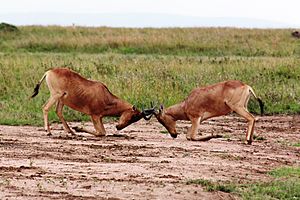Intraspecific competition facts for kids
Have you ever seen two animals of the same kind fighting? Maybe for a tasty snack or a cozy spot? This is called intraspecific competition. It happens when animals or plants from the exact same species need the same limited things to survive. These things could be food, water, space, sunlight, or even a partner to have babies with.
When individuals compete, the one that wins usually has a better chance to live and reproduce. This competition is super important for how species change over time. It helps them become better suited to their homes through something called evolution.
Contents
What is Intraspecific Competition?
In nature, competition happens all the time. Intraspecific competition is a special kind of competition. It means that members of the *same* species are competing. Think of it like siblings competing for the last cookie! They are all part of the same family, but there's only one cookie left.
This is different from interspecific competition, where different species compete. For example, a lion competing with a hyena for food is interspecific competition. But two lions fighting over the same prey is intraspecific competition.
Why Do They Compete?
Animals and plants compete for things they need to live and grow. These are called resources. If there are not enough resources for everyone, competition starts.
Food and Water
One of the most common reasons for competition is food. If a group of zebras is in a field, and there isn't enough grass for all of them, they will compete. The stronger or faster zebras might get more food. The same goes for water, especially in dry places.
Space and Territory
Animals also compete for space. This can be a safe place to live, a good spot to hunt, or a territory to raise their young. Many birds, for example, will sing loudly to mark their territory. This tells other birds of the same species to stay away.
Sunlight
Plants compete too! In a forest, tall trees might block sunlight from smaller plants below. All plants need sunlight to make their food. So, they compete to grow taller or spread their leaves wider to catch more light.
Mates and Reproduction
For many animals, competition is about finding a partner to have babies with. This is called competition for mates. Male deer, like the hartebeest in the picture, often fight each other using their antlers. The winner gets to mate with the females. This kind of competition helps ensure that the strongest and healthiest individuals pass on their genes.
How Does Competition Affect Species?
Intraspecific competition plays a big role in how species change over time. It's a key part of natural selection.
Survival of the Fittest
When individuals compete, the ones that are better at getting resources are more likely to survive. They are also more likely to reproduce and have offspring. These offspring often inherit the traits that helped their parents win. Over many generations, this can lead to a species becoming better "adapted" to its environment. For example, if faster deer get more food, over time, the deer population might become faster.
Population Growth
Intraspecific competition also affects how many individuals can live in an area. If a population grows too big, there won't be enough resources for everyone. This can slow down population growth or even cause the population to shrink. This is why populations often follow a "logistic growth" pattern, where they grow quickly at first, then slow down as resources become limited.
Images for kids
See also
 In Spanish: Competencia intraespecífica para niños
In Spanish: Competencia intraespecífica para niños




